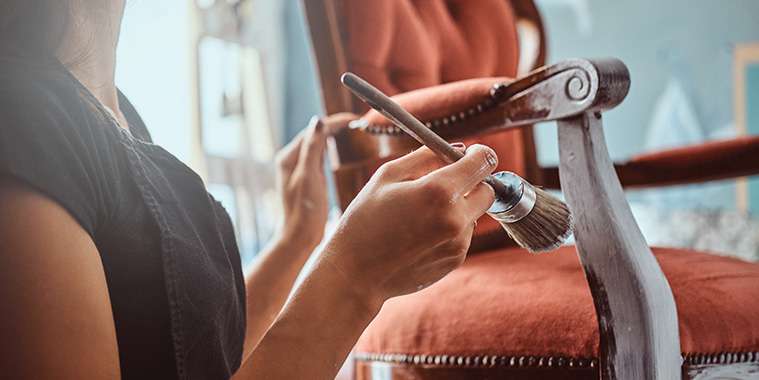Whether you buy it at a garage sale or it’s already gathering dust in your home, old furniture can become new again — or, at least, look like it.
You can customize things to reflect your individual taste for a fraction of what you might spend buying entirely new décor. And what you save in cash could more than make up for the time you spend restoring the furniture, depending on your creativity and tastes.
As with any type of interior design, the more you plan, the better your results will be. Knowing the possibilities and limitations of different decorating tactics will help manage your expectations about redesigning.
With that in mind, here are some of the things you can do to make older furnishings look newer:
Drapery and Pillows
How: Housewares stores sell a wide variety of pillows, curtains, tablecloths, and even sheets that could cover up worn-out seating or - in the case of curtains and sheets - serve as makeshift doors. You could also buy fabric by the yard and make your own.
Pros: This is one of the simplest options you have for dressing up old furniture.
Cons: There’s only so much you can achieve with this type of outer layer. Overdo it and the result can look cluttered.
Slipcovers
How: Most slipcover retailing happens via mail-order and websites, which makes comparison shopping a snap.
Pros: It doesn’t get much quicker and easier than this, especially if your furniture conforms to the exact dimensions of the slipcover.
Cons: Sizes and colors are limited, and catalog photos can only go so far in showing how something will look once it’s on your piece of furniture. One-size-fits-most can result in a loose fit that will look like you bought a slipcover instead of completely new décor.
Professional Upholstery
How: An upholsterer may pay you a house call to provide an estimate and save you from having to transport the furniture down to the repair shop.
Pros: The results might turn out better than anything you do yourself. The scope of services provided can include structural repairs, such as refilling stuffing, replacing springs, or strengthening frames.
Cons: It can easily cost as much as new furniture. If your item has sentimental value or qualifies as an heirloom, then hiring a professional upholsterer makes the most sense.
Do Your Own Upholstery
How: Take good measurements of your furniture, including the surfaces that are normally hidden from view - they are where you will be applying the staple gun. Buy upholstery-grade fabric with at least half a yard of excess to give yourself room for some trial and error.
Pro: You really can have a one-of-a-kind piece of furniture for a relatively modest investment of money. How much time it takes is up to you.
Con: This is the most challenging and time consuming of all the options mentioned here. Consult a good how-to guide (a number of them are linked throughout this article) or consider taking an upholstery class. Approach the effort as a learning exercise until you get the hang of it.
Painting or Refinishing
How: Invest in a good drop cloth, mask, gloves, solvent, and sandpaper when embarking on any kind of painting or refinishing job.
Pros: As long as you sand down the object first, and then apply the paint, stain or finish carefully, the end result can look just like new. This will be even more so if you follow it with new fixtures, as described below.
Cons: The odor is substantial, and so is the potential for kids or pets to get in the way or ruin the project if it’s not done in the right location. Plan accordingly.
Knobs and Handles
How: Handles or knobs on armoires, dressers, and entertainment units can wiggle loose or become tarnished. Instead of just replacing one that has fallen off or into disrepair, you could buy a new set in a completely different style and the result could look like a whole new piece of furniture.
Pros: New hardware can dramatically prolong the life of storage furnishings.
Cons: If you don’t measure the original hardware and the corresponding hole before going to the store, you may need to make another trip.
Headboards
How: Jazz up a plain bedframe by adding a headboard, or make an old one look newer with a fresh coat of paint or new fabric covering. If you’re really ambitious, you could make a footboard too, although that’s a little trickier. Any piece of wood or metal that is about the width of your mattress and at least a foot higher could pass for a headboard.
Pros: This gets you away from looking like you’re sleeping on a futon.
Cons: Beware of headboards that lean against the wall rather than attach to the frame (and good luck trying to make a footboard stay in place without using some tools).
As with any crafts project, go easy on yourself when trying your hand at the more creative tactics mentioned here. Don’t be afraid to cut your losses if the end result isn’t what you had envisioned. That’s one of the benefits of refurbishing something old instead of buying completely new: You can always sell, trade, or give away anything that doesn’t turn out the way you had hoped.
— realtor.com



